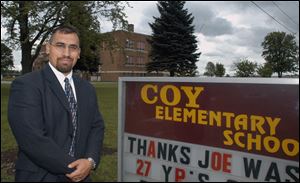
Local districts sorting out changes in state grading
8/26/2013
Lonny Rivera has been superintendent of Oregon City Schools for less than a month, and he’s already got lots to digest. Mr. Rivera, a longtime educator and former principal, has seen report cards before, but the state threw him a curveball and changed how it graded schools.
Lonny Rivera has been superintendent of Oregon City Schools for less than a month, and he’s already got lots to digest.
A new school year started Wednesday, and the next day school report cards were released by the state last week. Mr. Rivera, a longtime educator and former principal, has seen report cards before, but the state threw him a curveball and changed how it graded schools. Such is life for school officials.
“Being at the helm for three weeks, there’s a lot of data we have to dig through,” Mr. Rivera said.
Related
Searchable database by school district.
Searchable database by school.
NW Ohio school report cards (Note: Large file)
There is no overall grade for schools or districts this year and won’t be until 2015. Instead, there are up to nine measures this year for each school and district, such as a performance index, which is a weighted average of a school or district’s students’ scores, and “value added,” a measurement that tries to show how much students improved academically in a year.
Oregon’s report card was a mixed bag. Students scored about the same on the state standardized tests as they had the year before, but the district received two B’s, three C’s, a D, and three F’s in the graded categories.
Of those F’s, two were in categories related to value added. While the data are still fresh and Mr. Rivera said it was hard to diagnose exactly what the scores mean, district staff believe they have had weak performance in middle school grades for some time. The district has undergone a reconfiguration in grades five through eight and converted middle schools Eisenhower and Fassett. Eisenhower is now a middle school with grades five and six, while Fassett is a junior high with grades seven and eight. Mr. Rivera believes the new setup is more conducive for learning and should help the district target improvements in those grades.
The district received an F for value-added scores for disabled students. Mr. Rivera said Oregon plans to transition more of those students into traditional classrooms that will be team-taught by general and special education teachers. Exposing disabled students to general core curriculum should help them perform better on state tests, Mr. Rivera said. It’s similar to an approach taken recently by Toledo Public Schools, and that district got high marks for its disabled student’s value-added scores.
The district also got an F in a new category meant to determine how well districts closed the achievement gap with student subgroups. That new measure, called annual measurable objectives, replaces the adequately yearly progress metric. And Oregon wasn’t the only area district to do poorly on that measure.
While the Sylvania School District received four A’s and four B’s, it got a D in gap-closing. Superintendent Brad Rieger and Adam Fineske, executive director for curriculum and assessment, attributed the low annual measurable objectives score to the broad spectrum of special needs children being measured the same way.
Washington Local, which had its highest test scores ever, got an F in the gap-closing measure, a point of frustration for Superintendent Patrick Hickey, who called the metric confusing and difficult to explain.
And Mr. Rivera joined other educators who pointed to the strong correlation between socioeconomic status and report card results. The three lowest-scoring Lucas County districts also have the lowest income levels. The Ottawa Hills district was the best performer in the county.
Contact Nolan Rosenkrans at: nrosenkrans@theblade.com, or 419-724-6086, or on Twitter @NolanRosenkrans.